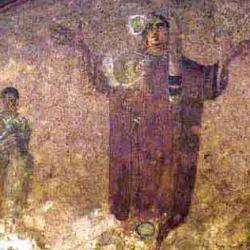Building on John Paul II’s theology of the body, Adam Cooper’s Holy Eros sketches out a “liturgical theology of the body.” He aims to show “how the liturgy bodily enacts the truth of our Christian faith, and how that truth in turn is expressed in the structure and bodily actions of Christian worship and the life of Christian discipleship” (1). Insofar as it is enacted in the liturgy, theology itself is “fundamentally a doxological, liturgical and thereby physical activity” that “enables participation in the intimate life of the holy Trinity” (5). Taking a cue from John Paul, this participation in the life of God is fundamentally “nuptial.” It involves a “performative nuptiality” in that “the liturgy physically performs or enacts the spousal union between Christ and his bride” (6).
Cooper begins with a treatment of the metaphysics of passivity and receptivity. He is aware of the anti-metaphysical bias of much recent sacramental and liturgical theology (Chauvet, for instance), and believes that this critique offers some essential warnings and cautions. In the end, we cannot avoid metaphysical questions.
Cooper’s treatment of the metaphysics of receptivity starts out with some bumps. He claims that “Before a being is a being of a certain kind, even before we can speak of its nature and potential, it exists!” In a footnote, he explains that the priority here isn’t temporal, but ontological and conceptual, but I’m still doubtful (12). Can we even talk about the existence of a thing except as an abstraction from a particular kind of existing thing? It seems we can talk about the “existence” of a tree only after we have experienced it “existing-as-a-tree.” Later Cooper argues that all existence is existence-in-relation. He observes that “relation implies a subject that relates,” a “starting point” for relation, but immediately adds, “this starting point is itself constituted by relation” (13). If that is the case, then why would sheer “existence” be considered the most fundamental fact about it?
Cooper’s initial treatment of passivity also raises questions. “Receptivity indicates some kind of lack, indeed, a lack of being, and a potency in need of actuation” (14). To which one is immediately inclined to say, The Trinity? Cooper eventually gets to that to, in this very fine statement: “If reciprocity and therefore receptivity are proper to [God’s] inner life as Father in relation to the Son, then those being who bear his image, who issue into existence in time from the eternally creative and fecund fount of that relation, must also carry in themselves an essential receptivity that indicates not so much some lack of being as the very clue to understanding the way of human perfection. Just as in the Trinity there is a certain kind of active passivity, a receptive ‘letting be’ by which the Son is freely begotten and the Spirit freely proceeds from the eternal giving of the Father, so it is as a person receives, is acted upon, and gives that he most perfectly ‘is.’ . . . receptivity is ineradicably inscribed within act. It is to specify the nature of activity in terms of a free and conscious receptivity, a receptivity to divine love” (17).













